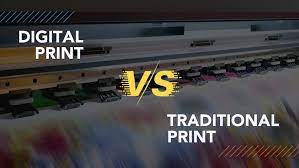Digital Printing: A Modern Approach
Digital printing involves reproducing digital images directly onto various media substrates, bypassing the need for traditional printing plates. One of the significant advantages of digital printing is its versatility and speed. It allows for quick turnaround times, making it ideal for short print runs and projects that require rapid delivery. Additionally, digital printing offers cost-effective solutions for printing small batches or personalised materials, catering to the great demand for customised content.
However, digital printing may not always deliver the same level of colour accuracy and consistency as traditional printing methods. Variations in digital printers and substrates can sometimes result in slight discrepancies in colour reproduction, which may be noticeable in high-end or large-scale print projects. Furthermore, while digital printing excels in producing small quantities efficiently, it may become less cost-effective for larger print runs compared to traditional offset printing.
Traditional Printing: Time-Tested Craftsmanship
Traditional printing methods, such as offset printing, have been the cornerstone of the printing industry for centuries. Utilising techniques like lithography, offset printing transfers ink from a plate to a rubber blanket and then onto the printing surface, resulting in high-quality prints with precise colour reproduction. This meticulous process ensures consistent quality across large print runs, making it the preferred choice for projects requiring high volume and precise detail, such as magazines, catalogues, and newspapers.
Despite its exceptional quality and reliability, traditional printing often entails longer setup times and higher initial costs compared to digital printing. The need for creating printing plates and the setup of complex machinery contributes to extended lead times, which may not be conducive to urgent printing needs. Additionally, traditional printing may pose challenges when it comes to customisation and variable data printing, limiting its suitability for projects that demand individualised content, a factor worth considering in contemporary Printing in Brisbane.
Environmental Considerations
In recent years, environmental concerns have become increasingly significant in the printing industry. Digital printing holds an edge over traditional methods in this aspect, as it typically generates less waste and requires fewer chemicals during the printing process. With growing awareness and regulations regarding sustainable practices, businesses and consumers are increasingly opting for eco-friendly printing solutions, making digital printing a favourable choice for environmentally conscious projects.
However, it’s essential to recognise that both digital and traditional printing methods have made strides towards sustainability. Traditional printers are adopting eco-friendly practices by investing in efficient machinery, recycling programs, and soy-based inks, mitigating their environmental impact. Ultimately, when deciding between digital and traditional printing you should consider not only immediate printing needs but also long-term sustainability goals.
To sum up, both digital printing and traditional printing methods offer distinct advantages and disadvantages. Digital printing excels in flexibility, speed, and cost-effectiveness for short print runs and customised projects but may lack the precision and cost-efficiency of traditional printing for large-scale productions. On the other hand, traditional printing ensures unparalleled quality and consistency for high-volume prints but may entail longer lead times and higher upfront costs. Ultimately, the choice between digital and traditional printing hinges on factors such as project scope, budget, timeline, and environmental considerations, all of which warrant careful evaluation to achieve optimal printing outcomes.



